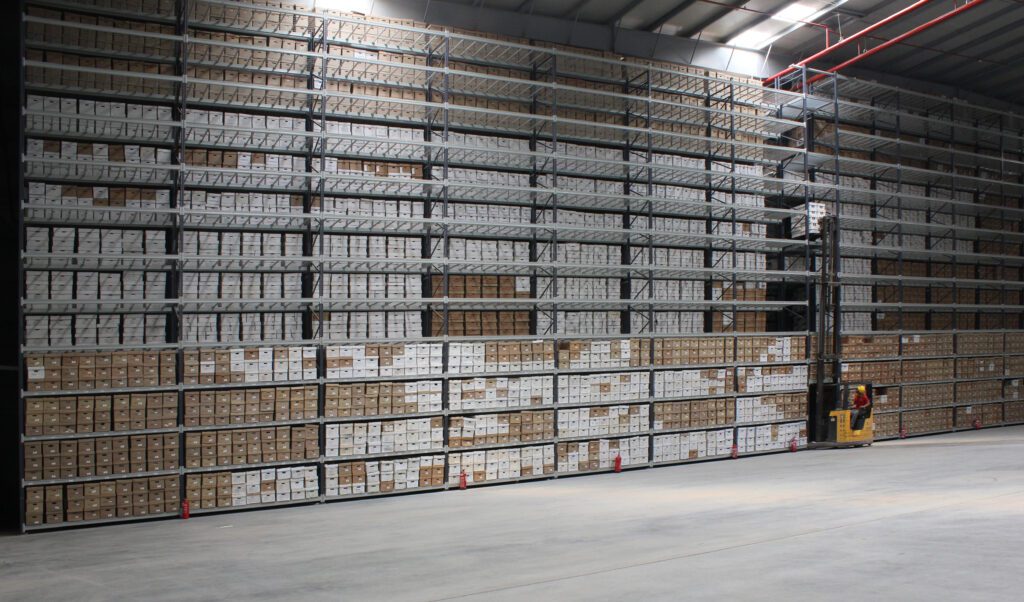Demand for warehouse facilities in urban areas has increased as e-commerce giants launch same-day delivery services. This eventually fueled the industrial racking systems’ demand in North America. The acceleration during COVID and now with higher gas prices ensures the trend and demand for industrial racking and shelves will continue.
According to the new report published by The Brainy Insights, the global industrial racking systems’ market is expected to grow from $10.30 billion in 2020 to $18.76 billion by 2028 at a CAGR of 7.71%.

The food and beverage industries are experiencing extreme competition which requires such companies to provide more efficient logistics and operational facilities. Logistics companies are setting up warehouse facilities near urban and suburban locations with strong consumer demand. These trends are causal to an ever-stronger demand for shelving and racking solutions.

New sources for warehouse racking
Supply chain disruptions have caused many who previously sourced products from China and Vietnam to seek alternatives such as Egypt-based LinkMisr International. Since industrial racking is an integral part of warehouse facilities that can impede or speed up warehouse operations, warehouse managers are seeking reliable, tested, and trusted vendors to maximize capacity. Warehouse organizations, from distribution centers to 3PLs, are seeking efficiency and a streamlined picking process.
Guaranteed and timely delivery of warehouse shelving is paramount.

The global market for industrial racking systems is inextricably linked with trade volumes, the manufacturing sector, and e-commerce. The invasion of Ukraine, ongoing COVID impacts, and logistics supply chain challenges, rises and falls on the news cycle. The total supply chain storage demand will only rise for the rest of this decade. The logistics industry sector is one of the largest and fastest-growing sectors.

Key players are now concentrating on implementing strategies such as adopting new technology, product innovations, mergers & acquisitions, joint ventures, alliances and strategic partnerships to improve their market position ensuring supplier diversification and avoiding supply chain constraints.
Racking types with great growth projected
Racking is divided into cantilever racking systems, selective pallet racking systems, drive-in/drive-thru pallet racking systems, push back pallet racking systems and others. Selective pallet racking systems are the most common mode of racking since it allows order picking at lower levels and unfettered access to any pallet; the selective pallet racking system segment led the global industrial racking systems market with a market share of 24% and a market value of around $2.47 billion in 2020.
Medium-duty racks segment is anticipated to grow at the highest CAGR of around 8.4% over the next decade. The carrying capacity segment includes light duty racks, medium duty racks, and heavy-duty racks. Due to their characteristics, medium-duty racks can be conveniently used in all divisions of industry.
Geographic racking segmentation
North America experienced an expansion in distribution centers as international exchange and e-commerce grew. The North America region emerged as the largest market for the industrial racking systems, with a market share of around 27.5% and a market value of about $2.83 billion in 2020. When e-commerce companies, including Amazon introduced same-day delivery services, demand for smaller facilities increased in urban areas.

Simon Armanious shared, “LinkMisr aims to achieve our business objectives in a responsible manner recognizing the economic, social, and environmental impacts of our activities.” LinkMisr assesses and monitors the impact of its activities against internationally recognized ISO standards including ISO 9001, ISO 14001, and ISO 45001. The Cairo-based firm is committed to conducting business in a manner which achieves sustainable and profitable growth while simultaneously fulfilling its legal and moral obligations.
Environmental Impacts
Minimizing the environmental impact of manufacturing activities is demonstrated through the prevention of pollution, minimizing waste, promoting good environmental management practices, and using environmental management systems which are consistently and rigorously audited through ISO 14001.
ISO 14000 is a family of standards related to environmental management that exists to help organizations minimize how their operations negatively affect the environment; comply with applicable laws, regulations, and other environmentally oriented requirements while practicing continuous process improvement.
Corporate social responsibility: No longer optional
Operating sustainably has become a source of competitive advantage and unlocking its potential relies on building strong stakeholder relationships. New research reveals large consensus gaps between leaders and stakeholders on sustainability performance. This misalignment obstructs the link between sustainability and profitability.
Executives at LinkMisr have strengthened the organizations’ sustainability DNA by adopting a change model to diagnose, define, and develop best-practice performance metrics. By closing consensus gaps and operating more sustainably, businesses like LinkMisr are delivering greater financial value in tandem with positive environmental and societal impact.
Author Profile

Thomas R. Cutler is the President and CEO of Fort Lauderdale, Florida-based, TR Cutler, Inc., celebrating its 23rd year. Cutler is the founder of the Manufacturing Media Consortium including more than 9000 journalists, editors, and economists writing about trends in manufacturing, industry, material handling, and process improvement. Cutler authors more than 1000 feature articles annually regarding the manufacturing sector. Cutler has established special divisions including Africa Manufacturing, Gen Z Workforce, and Food & Beverage Manufacturing & Logistics. Cutler was named the Global Supply Chain journalist of the year. Over 5200 industry leaders follow Cutler on Twitter daily at @ThomasRCutler. Contact Cutler at [email protected].
Related posts
- 13 Most Important Warehouse Processes
- 7 Best Warehouse Management Practices
- What Is Warehousing?
- Logistics Warehouses Quickly Adopting Automation to Reduce Walk Time
- What Is On-Demand Warehousing?
- How to start a warehouse business
- Warehouse Management Systems (WMS): Benefits and Best Practices
- 8 Key Functions Of Warehouse Management System (WMS)
- 6 Major Benefits Of Bonded Warehouse
- 4 Key Types Of Warehouse Management System (WMS)
- Optimize Your Logistics with Stockarea’s Revolutionary On-Demand Warehousing Solutions
- Top 11 Warehousing Companies In Hyderabad [2024 List]
- 10 Types Of Pallets In Warehousing